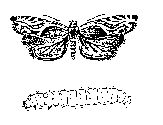Strawberry Leafrollers
Ancylis comptana fragariae
The strawberry leafroller, Ancylis comptana fragariae, was inadvertently introduced into North America from Europe in the 1800s and was recorded as a pest of strawberries in Illinois over 125 years ago. It is now distributed throughout the United States.
Biology
Strawberry leafrollers overwinter as larvae or
pupae in folded leaves or leaf litter. Adult moths emerge in April and
May and deposit translucent eggs, usually on the lower surface of
strawberry leaves. Moths are reddish brown, with distinctive yellow
markings on the forewings; their wingspan is approximately 1/2 inch. As
larvae feed and grow, they change from pale green to grayish brown in
color. Mature larvae reach a length of 1/2 inch.

Strawberry Leafroller,
adult and larva. Adults wingspan
and larval length are about 1/2 inch.
Damage
As larvae feed, they secrete silken threads to fold
and tie strawberry leaflets together. Within these folded leaves,
larvae feed on only the epidermis of each leaf, but entire leaflets
usually turn brown.
The strawberry leafroller completes 2 or 3 generations of development each year, and moths of the summer generations are often present from July through September. Infestations may develop in spring and early summer, but they may also build up after harvest.
Control
Two parasites, Macrocentrus ancilovorous and Cremastes cookii,
often kill a high percentage of strawberry leafroller larvae,
especially during summer generations. Low levels of leafroller
infestation (ill-defined, but perhaps 10 to 20 percent of strawberry
leaflets, especially after harvest) do not warrant control because they
do not cause reductions in plant vigor or yield during the current or
subsequent season. Where control is necessary, consult the most recent
edition of the Illinois Commercial Small Fruit and Grape Spray Guide for a listing of registered insecticides.
The obliquebanded leafroller and the blueberry leafroller also feed on strawberry foliage, but although both are common on several fruit crops and weeds, neither commonly causes significant damage to strawberries. The nature of the damage that they cause is similar to that of the strawberry leafroller, and the same insecticides may be used for their control in the rare instances where treatment is warranted.
Although leafrollers occur in many fields, these pests do not damage berries directly and often do not reach high densities. Consequently, controlling them is often unnecessary. Insecticide applications for the control of foliage-feeding pests can and should be based on scouting results, not preventive spray programs.